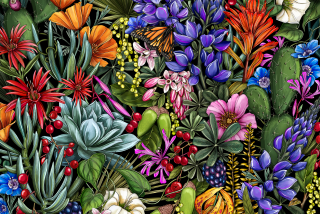Friendly Ferns : Ancient Plants Can Be Easy to Grow Indoors or Out
- Share via
From the beginnings of humankind, the beautiful and exotic fern was there. Ferns predate our own species by hundreds of millions of years. The fossil record indicates they reach back into the Coal Age--the Carboniferous Period, beginning about 345 million years ago. Some scientists say they are perhaps even older.
Estimates of the number of species range from 9,000 to 15,000. These two figures are so far apart because some ferns remain unstudied, and new kinds are still being discovered in remote regions of the tropics.
In size, ferns range from specimens about one-tenth of an inch long to tree ferns that soar to 50 feet and above.
The seedless, flowerless plants grow in almost every land area not covered by permanent ice. Some even live floating on the surface of ponds.
Ferns are at their most profuse in warm, damp regions. In tropical rain forests, more than 100 species have been seen in only a few acres.
In 1795, Capt. William Bligh of Bounty fame took back to England 37 species of ferns from the West Indies. In that era, many of the tropical varieties were very expensive and were owned only by the wealthy.
Popular interest in ferns was revived in the 1960s, a period that featured advances in various methods of propagation, particularly within the science of tissue culture (cloning).
Today, you can buy large, lush specimens of the ferns listed below for $10 to $15 at nurseries and markets.
Contrary to some beliefs, almost all ferns are easy to grow.
In addition to doing well indoors, the ferns pictured here will thrive outdoors in Southern California, if they receive filtered sunlight and are protected from the hot summer winds. The best outdoor varieties also include tree ferns, the holly fern, the sword fern and footed (polypodium) ferns. Unlike the indoor varieties, outdoor ferns should be kept in moist soil.
The Los Angeles International Fern Society is an excellent place to enter the world of ferns. For information on meetings, write to Membership Secretary Dave Fay, P.O. Box 90943, Pasadena, Calif. 91109, or telephone President Don Wood, (213) 698-7696.
The plants below were chosen for their easy-to-grow qualities as well as their appeal as decor-enhancing living objects. If you stick to the rule of underwatering, you’ll find ferns friendly.
Santa Rosa (Aglaomorpha). This is a classic case of “ugly duckling / beautiful swan.” Slow growing but ultimately a spectacular basket, it’s an eye catcher. The crown grows horizontally. Must be allowed to barely dry between waterings.
Boston (Nephrolepis exaltata) . This natural variation of the sword fern was first recognized by a Boston florist in 1894. The fronds are long and graceful.
Japanese bird’s nest (Asplenium nidus antiquum). This produces a lush nest of overlapping fronds. It tolerates a wide range of temperatures and light levels. Needs good soil drainage.
Elegance (Davallia denticulata). Graceful foliage, glossy-green fronds and year-round vigor mark this fern. Plant in a large basket for best results.
Rabbit’s foot (Davallia trichomanoides). This is considered the most versatile and decorative of ferns. Indoors or outdoors, it’s happy as long as it isn’t overwatered.
Maidenhair (Farleyense adiantum tenerum). This plant, discovered in 1865, is considered by many the most beautiful of all ferns of this type. New fronds open above others in a spectacular pale red color that resolves into a green hue. Keep moist but never soggy.
Trevillian (Nephrolepis exaltata). This fern, sometimes known as Verona lace, grows rapidly. In a hanging basket the cascading fronds will reach just below the bottom of the pot.
Porter’s Roosevelt (Nephrolepis exaltata). This mutant of the Boston fern was cloned and introduced in 1981 by Santa Rosa Tropicals, a business in Santa Rosa, Calif. It bears a similarity to the Boston fern in its graceful cascade effect, but Porter’s Roosevelt is much more ornate, with incredibly lacy fronds.
Cobra ( Polypodium polycarpon) . The unfolding “fiddle heads” bear a strong resemblance to the raised head of a cobra. (“Fiddle heads” are the immature and tightly curled fronds, which straighten as the plant grows.) Does well in a basket or mounted on driftwood.
Staghorn (Platycerium bifurcatum) . This fern attracts attention in almost any setting--on a patio, in a well-lighted area of a home or on a tree in the garden. The name “staghorn” comes from the plant’s distinctive fronds.
Tips for Growing Ferns
Light: Filtered sunlight or tree-shaded.
Temperature: Fastest growth at between 78 and 85 degrees Fahrenheit. Night temperature as low as 50 degrees will not hurt most ferns.
Watering: Do not drown your plants. The hair-like roots of ferns need oxygen to keep the plants healthy, and overwatering interferes with the process. If you allow the soil to become almost dry between waterings, indoor ferns will respond with vibrant growth.
Soil recommended by UC Davis agriculture department: one-third peat moss, one-third perlite and one-third redwood mulch.
Fertilizer: In a well-drained mix, ferns should be fertilized with each watering. Use a 20-20-20 liquid mixture according to label directions.






